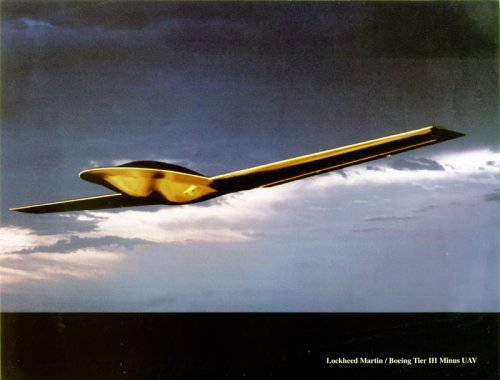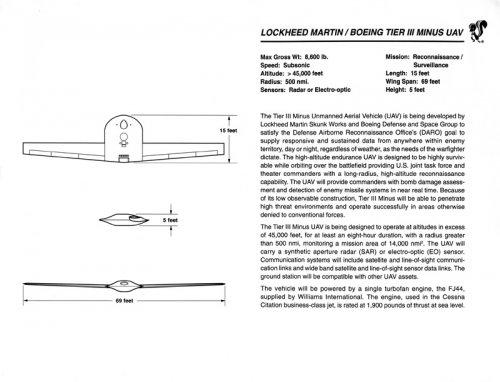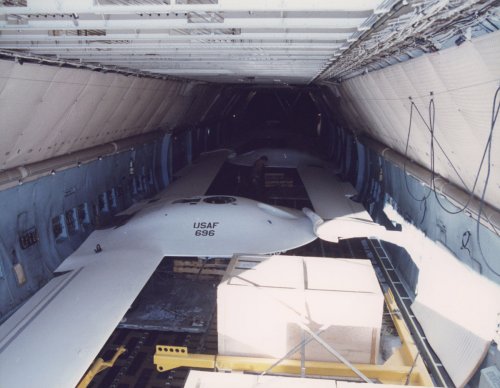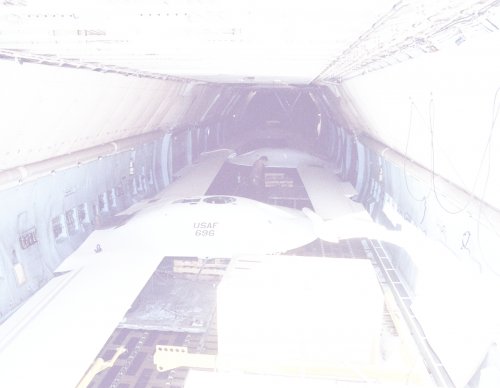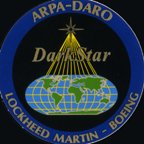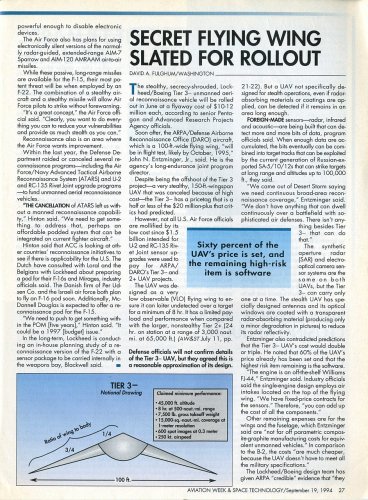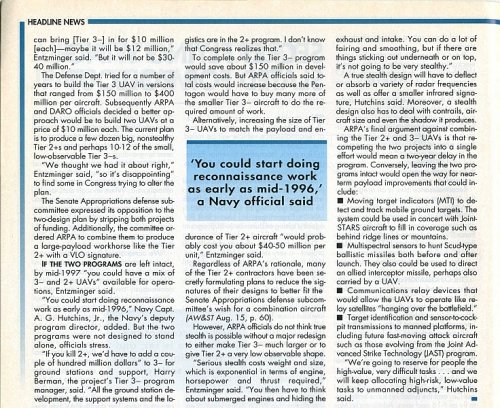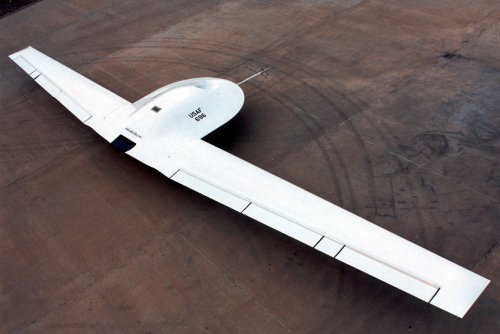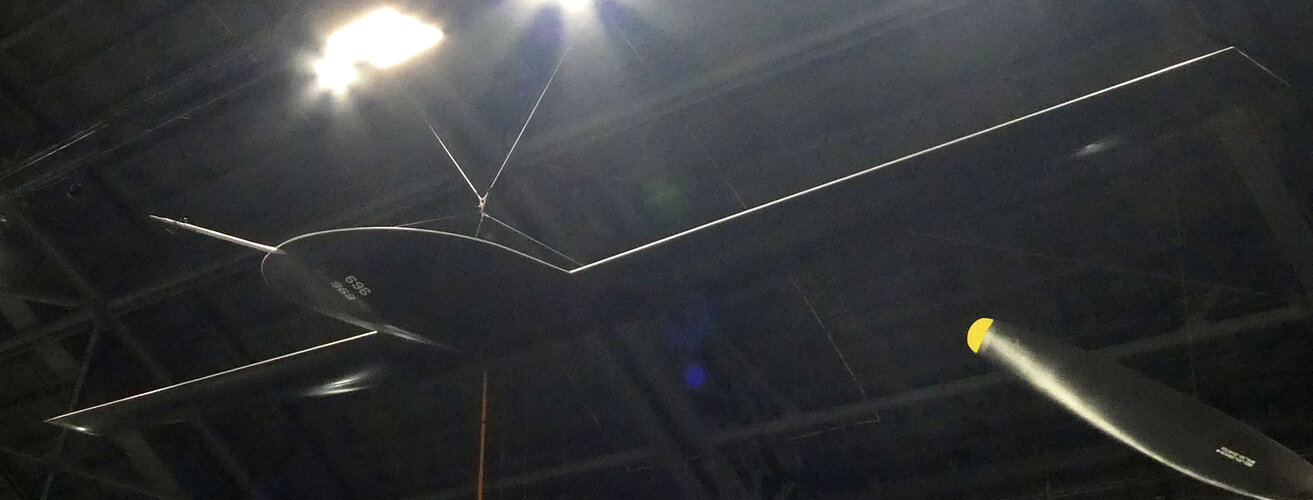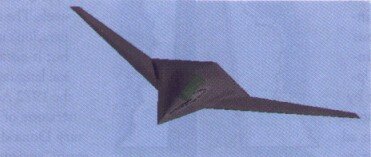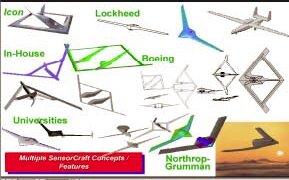You are using an out of date browser. It may not display this or other websites correctly.
You should upgrade or use an alternative browser.
You should upgrade or use an alternative browser.
Lockheed Martin RQ-3A DarkStar
- Thread starter flateric
- Start date
- Joined
- 1 April 2006
- Messages
- 10,759
- Reaction score
- 6,837
Tight Fit
Two of the three Lockheed Martin RQ-3A DarkStar unmanned aerial vehicles built are shown packed in a C-5B Galaxy on their final flight from Palmdale, California, to the US Air Force Museum at Wright-Patterson AFB, Ohio, in December 1999. DarkStar first flew on 29 March 1996, but it crashed during its second flight a month later. The second DarkStar (shown at left) was modified to increase its stability and first flew on 29 June 1998. It is now on display at the museum at Wright-Patterson. Two additional DarkStar vehicles (including the one on the right) were completed, but they never flew. One of those aircraft is on display at the National Air and Space Museum in Washington, DC, and the other is on display at the Museum of Flight in Seattle, Washington. In January 1999, the Department of Defense terminated the DarkStar UAV program because of budget cuts. The C-5 that carried the DarkStars was based at Travis AFB, California.
Photo Posted: 9 September 2010
http://www.codeonemagazine.com/gallery_slideshow.html?item_id=822
Attachments
- Joined
- 17 October 2006
- Messages
- 2,312
- Reaction score
- 717
John21
ACCESS: Confidential
- Joined
- 27 May 2007
- Messages
- 150
- Reaction score
- 11
Does this mean they built more than three? Its says in the text that out of the three built one crashed. But since this photos was taken in 1999 AFTER the crash of one of the DarkStars what is the third one doing there? ;D
aero-engineer
ACCESS: Restricted
- Joined
- 9 July 2007
- Messages
- 49
- Reaction score
- 2
Steve Pace
Aviation History Writer
- Joined
- 6 January 2013
- Messages
- 2,266
- Reaction score
- 172
bartenational
ACCESS: Restricted
- Joined
- 20 January 2021
- Messages
- 12
- Reaction score
- 24
Saw This at
This RQ-3 blew my mind, not sure how that thing could be controlled? any info would be great.
National Museum of the US Air Force last weekend along with their expanded X planes on display.
This RQ-3 blew my mind, not sure how that thing could be controlled? any info would be great.
Attachments
Last edited by a moderator:
I was at the B-2 CTF that day it crashed. From what I understand, Boeing had the flight control software and there was no way to reject the takeoff, there were issues right from the git-go during the takeoff roll. We could smell the burning composite from South Base, got a nickname, Falling Star (one of the nicknames anyway). It was some time ago and anyone please correct me if I'm wrong.
Trying to understand the whole story ... DarkStar was a scaled-down AARS / QUARTZ super-drone - itself the "real" SR-71 replacement in the 1980's ? trading speed for persistance, to try and pin down Soviet mobile ICBMs ?
- Joined
- 1 April 2006
- Messages
- 10,759
- Reaction score
- 6,837
ok -- https://www.secretprojects.co.uk/th...tems-w570-arrow-shadow.511/page-4#post-422885
Polecat shape too.
Polecat shape too.
Last edited:
- Joined
- 16 January 2015
- Messages
- 724
- Reaction score
- 2,557
With the original Lockheed-only effort being "a swept high aspect ratio flying wing with a pointy nose", similar to the X-56's shape.
Which gives me reason to believe that this picture taken in the house of former Lockheed's employees, where Ronnie Olsthoorn's rendition of the RQ-180 was put in a frame, was there more as a stand-in for a QUARTZ representation rather than to show the Northrop Grumman product.
Which gives me reason to believe that this picture taken in the house of former Lockheed's employees, where Ronnie Olsthoorn's rendition of the RQ-180 was put in a frame, was there more as a stand-in for a QUARTZ representation rather than to show the Northrop Grumman product.
- Joined
- 1 April 2006
- Messages
- 10,759
- Reaction score
- 6,837
I remember this one cranked kite concept that has appeared two times in AWST (2001 and 2003) long before SensorCraft development timeline was published, both times referred as 'one of Air Force concepts studied'. Note that both LM and NG have cranked kites HALE concepts studied and I guess LM flying wing SC have roots in AARS/Quartz
Attachments
Last edited:
It was basically a PIO issue. The flight control computers got out of phase with the airplane dynamics....with predictable results.I was at the B-2 CTF that day it crashed. From what I understand, Boeing had the flight control software and there was no way to reject the takeoff, there were issues right from the git-go during the takeoff roll. We could smell the burning composite from South Base, got a nickname, Falling Star (one of the nicknames anyway). It was some time ago and anyone please correct me if I'm wrong.
Scott Kenny
ACCESS: Above Top Secret
- Joined
- 15 May 2023
- Messages
- 6,370
- Reaction score
- 5,234
How does that happen with computers?!?It was basically a PIO issue. The flight control computers got out of phase with the airplane dynamics....with predictable results.
- Joined
- 6 August 2007
- Messages
- 3,043
- Reaction score
- 2,439
How does that happen with computers?!?
Software
- Joined
- 6 November 2010
- Messages
- 4,256
- Reaction score
- 3,201
Software built to specifications will suffer if those specifications do not sufficiently match real-world conditions. Computers themselves are not immune to environmental factors (shock resistance, temperature resistance, g-limits, etc.), and processor speed is finite - overload! Sensor-processor interface may be compromised. Sensors themselves may mangle sensing relevant dimensions of the environment they are collecting data from. Design may overlook relevant dimensions, or weigh them incorrectly.
That's just the input part...
That's just the input part...
Purpletrouble
ACCESS: Secret
- Joined
- 16 September 2019
- Messages
- 449
- Reaction score
- 349
It’s still a pilot induced oscillation, although many would say that is harsh as it imples blame.How does that happen with computers?!?
Traditional PIO events were/are due to couplings between controls/aircraft response modes and the pilot input with classically the handling being too unresponsive such that the pilot makes bigger and bigger inputs to get a desired response, then in panic makes bigger and bigger counter inputs as the response starts to deliver the original inputs. The result being divergent and usually bad.
Computers can take that out certainly (although some aeroelastic effects are always a concern), but if software and/or hardware have too big a time lag between inputs and response the pilot (or computer if say fully computer opntrolled) will again start to drive the system in a PIO manner. That is quite possible given the sw/hw links in the chain and needs careful requirements and design to avoid.
It gets really technical after this and involves bode plots etc. where you can assess the system response’s stability and risk of this behaviour.
Did this come from the SDASM or somewhere else?AV-1 RAD event April 22,1996 screenshots
I remember this one cranked kite concept that has appeared two times in AWST (2001 and 2003) long before SensorCraft development timeline was published, both times referred as 'one of Air Force concepts studied'. Note that both LM and NG have cranked kites HALE concepts studied and I guess LM flying wing SC have roots in AARS/Quartz
Can someone point out the genesis of this carpenters square design? I'd like to get an idea of where/how it started being used.
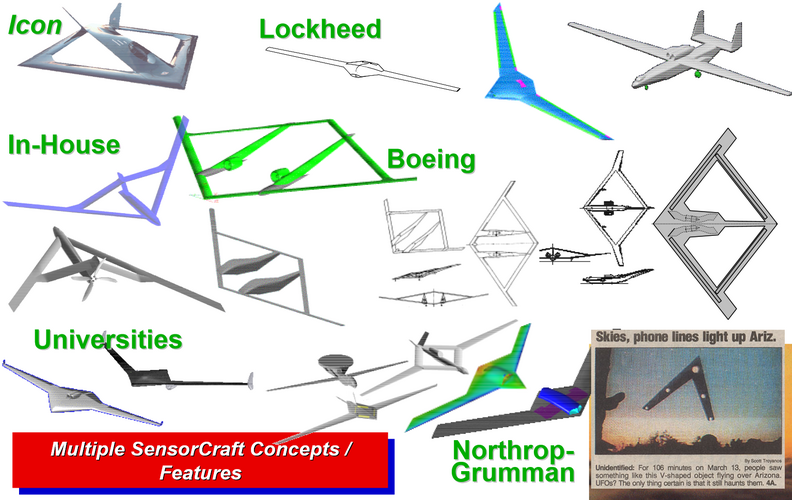
- Joined
- 6 August 2007
- Messages
- 3,043
- Reaction score
- 2,439
Can someone point out the genesis of this carpenters square design? I'd like to get an idea of where/how it started being used.
View attachment 729107
DWG
ACCESS: Top Secret
- Joined
- 11 February 2007
- Messages
- 1,762
- Reaction score
- 2,317
I always liked Pilot-in-the-Loop Induced Oscillation, which came up around the time of the YF-22 and Gripen incidents, but never really caught on. It better captures the pilot as only one element of the issue.It’s still a pilot induced oscillation, although many would say that is harsh as it imples blame.

